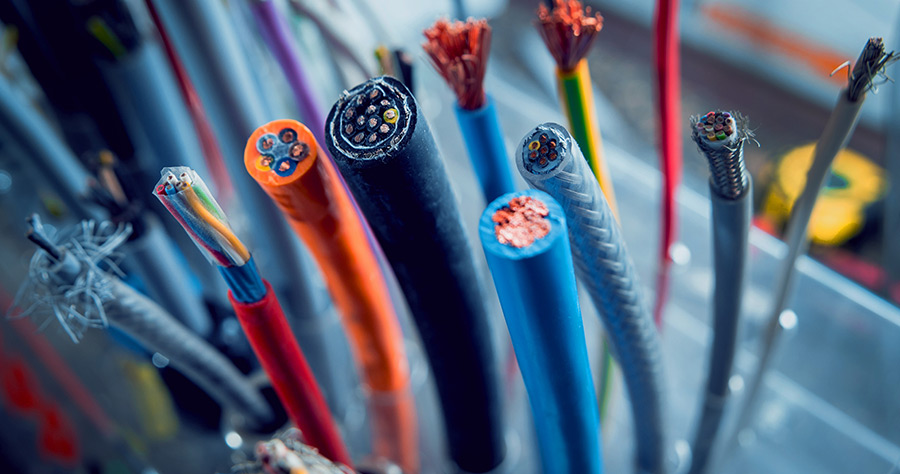
Electrical conductor: there are usually one or more copper wires. This is the part of the cable that transports electricity.
Insulation: protects and insulates the conductor and ensures that the current does not escape from the cable.
Layer of filling: this lies between the insulation and the conductor. This gives it a circular and homogeneous appearance.
Cover: protects the cable from the weather and external elements.
You also need to know the main types of cable:
- Depending on the number of conductive wires: unipolar (a single conductive wire), multipolar (more than one conductive wire) or hoses (two or three conductors surrounded by protection).
- Depending on the structure: flat, round, coaxial (with a copper-plated core), braided (formed by pairs of interlocking wires), etc.
- Depending on the type of driver: bare wire, insulated wire, flexible cable conductor or cord.
- Depending on the properties of the coating
- Depending on the type of insulation: thermoplastic or thermoset.
Taking the above into account, here are few tips to keep your cables looking like new:
Take care when rolling them up
The cables have copper wires inside. If you twist or bend them, these wires can be damaged, affecting how they work. To place them while using them or to store them when not, handle them gently and bend them carefully so as not to damage the copper wires.
When you roll them up, make sure that knots are not formed. Knots may also end up damaging the wires inside.
tore your cables carefully
When you are not using them, store them carefully. To keep them rolled up you can use a piece of Velcro, a wire or a rubber band.
Protect them by putting them in a plastic bag to protect them from moisture and dust.
Label them if necessary, so you can quickly identify them. You can indicate on the bag or on an adhesive label which domestic appliance they belong to or their main characteristics. If you have a number of them, you can put them in a plastic box, a trunk, a chest of drawers, etc. Store the cables you use less often in the least accessible place, keeping the ones you use close at hand. What is most important is for them to be well protected and organized so you can always find a cable when you need it.
We always recommend that you keep the cables you are really going to need. You can sell any cables you are no longer going to use so they have a second life. If you do not want to sell them or they are not in good condition, take them to a Recycling Centre.
Care during use
You should also take care how you use them. Cables usually start to deteriorate at the ends because they are often too tight when we use them. That is why it is recommended that there is always a certain amount of slack.
Never step on or squash a cable, especially when you are using it. It can cause damage that may result in an accident.
Never pull a cable. To disconnect it, hold the cable by the plug to pull it out.
Be careful where you leave your cables. Avoid damp areas, because this can cause damage. And do not leave them within reach of children and pets. Passageways are another place to avoid: Some people attach the cables to the skirting board or the wall to avoid tripping.
The best solutions are those that help you protect and organize your cables while you use them. From tubes, which carry the cables of one area to the multi-socket adaptor, to trays, etc. There are numerous gadgets you can use to help you get the result you want.
Clean them properly
Cables tend to get dirty and go yellow with use. To clean them you will need a chamois leather and some cleaning liquid. Some people go as far as using alcohol or a mixture of baking powder, cleaning vinegar and water. When the cable is not plugged in, moisten the cloth and pass it over the entire surface of the cable. If the dirt persists, you can always use a small brush. You may need to use the last mixture we mentioned to remove the yellowish color that white cables often acquire over time.
What should I do if a cable is damaged?
If you find that one of your cables is bare, do not connect it, it might cause a short circuit. If you have a voltage meter, check that there is no voltage in the cable: If there is voltage then the cable is working properly. If there is no voltage, then the cable has been damaged.
In that case, you can apply insulating tape around the damaged area, making sure to cover the damaged area tightly. Reconnect the cable and make sure there are no sparks or strange noises in the area.
When there is a short circuit, the cable may be damaged. Extreme temperatures, damp, poor maintenance, etc. There are many factors that can cause a short circuit. You generally see sparks or a fuse may be blown on the circuit board. After a short circuit, cut off the electricity in the place where it has occurred, to avoid any danger. You should then take a careful look at the cabling to see if there has been any damage. If you find any cable that has lost its insulation, protect it with insulating tape or replace it when this is not possible.
It is always best to take appliances to a technical service point where they can be inspected and repaired if necessary. If the problem is with the installation at your home, contact an electrician who will do what is required. If you are not 100% sure, go to a professional and never put your safety at risk.

 Admin
Admin
Leave A Reply
Your email address will not be published. Required fields are marked *